Biography
Interests
Abdelkader Abdellaoui
Avicenna Virtual Campus Network, France
*Correspondence to: Dr. Abdelkader Abdellaoui, Avicenna Virtual Campus Network, France.
Copyright © 2023 Dr. Abdelkader Abdellaoui. This is an open access article distributed under the Creative Commons Attribution License, which permits unrestricted use, distribution, and reproduction in any medium, provided the original work is properly cited.
Abstract
Among the great risks for the earth, we can cite three different types: global warming, conflicts that can degenerate into uncontrolled nuclear confrontations, and near-Earth objects that can cause considerable damage to the planet.
We rule out this third type of risk from the outset because programs for detecting, tracking and possibly destroying NEOs that come dangerously close to Earth are already tested and ready to be used in the event of imminent danger.
Global warming is a risk to be taken seriously. It is mainly due to greenhouse gas (GHG) emissions. Analyzes and forecasts show that the commitments to reduce the global temperature to 1° have not yet been kept and we are moving towards a point of no return and non-irreversibility of the phenomenon of destruction of the ozone layer and global warming.
The only conflicts that can generate a nuclear confrontation are those that bring together two major nuclear powers: USA-Soviet Union, USA-China, in particular. Other conflicts between intermediate powers should not lead to nuclear confrontations.
This article analyzes the consequences of global warming, the major conflicts between the nuclear superpowers and very briefly reviews the secondary conflicts.
It will highlight the difference between the superpowers and the other Nations, the poor of the planet, the forgotten and the left behind.
We also analyses the effects the consequences of the two great wars. The two great world wars (1914-1918 and 1940-1944) were appalling from all points of view: psychological, material, disorganization, political, geographical and governance
Introduction
Among the great risks for the earth, we can mention three different types:
• Global warming,
• Conflicts that could degenerate into uncontrolled nuclear confrontations
• Near-Earth cruisers which can cause considerable damage to the planet.
1. In November 2022: 2022 WW11 had been at a minimum distance from earth of 531196 km; WS5 was at 1861506 km; 2022 VB2 was at 3459807 km; 2022XC was only 703157 km away; WW11 was only a minimum distance from the land of
2. In December 2022: 2022 XA was 227 km away.
These data are provided by the “notre.planète.info” website consulted on December 4, 2022.
NEOs potentially dangerous to the Earth must be of a sufficiently large size (at least 100 m) and a trajectory passing at a distance of less than 8 million km.
Climate change refers to variations in temperature and climate in general. This may be due to natural
variations; but human activities have been the main cause since the 1800s, mainly due to the combustion
of fossil fuels (coal, oil, gas). Carbon dioxide and methane emissions cause climate change. The use of fossil fuels generates emissions of what are commonly called Greenhouse Gases (GHGs) and the destruction of
the ozone layer, which protects against solar radiation.
The energy, industry, transport, construction and agriculture sectors are the main emitters of GHGs. In 2022, we can already see that GHG concentrations are beginning to reach their highest level for two million years. Among the consequences of climate change, we can cite: increase in temperature on the surface of the globe, intense droughts, water shortages, forest fires, rise in sea level resulting in flooding cities and coasts, melting glaciers and polar ice, storms and declining biodiversity. Global discussions are trying to fix this increase at 2° and find commitments from States to limit their GHG emissions.
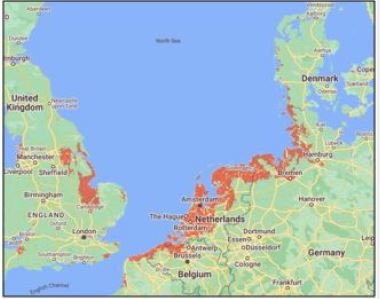
The climate crisis (rise in temperature that attempts to abandon activities generating greenhouse gases could not contain) will create a situation of new global tension. Many parts of the world are going to be below the 10-year flood stage. Fig 2 -les-consequences-du-réchaument-climatique_3811201.html) shows us that Europe is badly affected; it will however be necessary to add to this map Slovenia, Croatia, part of the Egyptian coast, Basra in Iraq, part of the coasts of Qatar, Bahrain of the United Arab Emirates, the coasts on the Gulf of Oman, a large part from the Indian coast and that of Bangladesh; Thailand, Laos, Cambodia and Vietnam are not spared. Few countries will be spared.
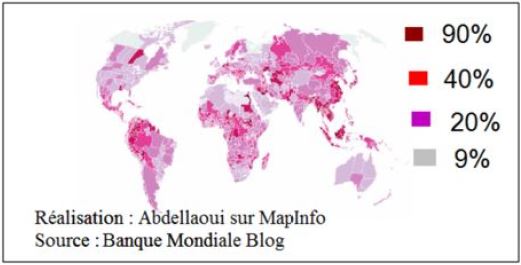
Figure (2) shows us in more detail the potential flood zones in the world following the increase in global temperature and the rise in sea and ocean levels. We can see that many countries are affected in South America, Africa, Europe and Asia. But what is most striking is that many of these regions correspond to the poorest or emerging countries, in any case the least polluting.
The super powers (particularly in space) have already set up colonization programs for the planets of our solar system: the Moon (Americans, Chinese and Russians), Mars (Americans). The objective is to constitute populations which would return to Earth and which would be able to perpetuate civilizations, cultures, fashions and traditions. Of course, not all individuals in these societies will be able to benefit from this targeted colonization. So all these Others who have not gone through the space box will try to emigrate to areas that have escaped the multiple conflicts and disturbances of the planet, such as the Maghreb, Egypt, Greenland and other rare areas which should begin to prepare for massive immigration, perhaps we will return to the methods employed a long time ago with the makeshift boats carrying citizens fleeing the intolerable conditions of their systems of life and governance towards the dream Eldorado that represents for them the West.
Note, however, that not all populations experience the effects of climate change in the same way; the poorest and least technologically advanced countries suffer from them much more than the advanced and rich countries which produce more GHGs than the poor countries.
A nuclear conflict or accident can also plunge the planet into desolation and catastrophe. The bombing of
Hiroshima and Nagasaki had plunged Japan into desolation; the consequences for people’s health are still
being felt years later. The Chernobyl accident could have had very serious consequences on the entire planet
if it had not been controlled.
Without saying so publicly, the great powers are busy in research and technology to develop weapons that would enable them to deter and, in the event of open conflict, to retaliate.
Figure (3) gives us an overview of the nuclear submarines of the USA and the Soviet Union. Figure (4) informs us about the other nuclear submarine powers and also about the nuclear attack submarines that equip the super powers: USA, China, France, United Kingdom and Soviet Union.
Reference: Wikipedia the free encyclopedia; https://fr.wikipedia.org/wiki/Liste_des_sous-marines_ nucl%C3%A9aires#:~:text=Today%2C%20only%20six%20forces,since%202009%2C%20India.
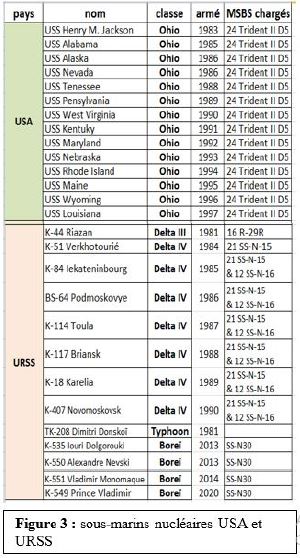
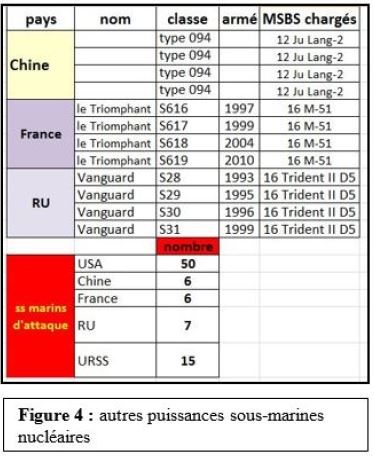
It is quite clear that an accident, a bad interpretation or an untimely decision can happen quickly.
The conflicts in the world are so numerous, we quote some of them for the record according to the following references: Wikipedia (2022) [1]: conflicts in the current world 2022, Chignier-Riboulon 2022 [2] and D. Gallas (2022) [3]: “Ukrainian-Russian war: beyond, 7 other bloody conflicts in the world today”; BBC News Brazil; March 2022.
Conflicts in Today’s World
In Palestine cut in two (Israel and the Gaza Strip), Jews and Arabs could have lived in harmony if there were not irreconcilable interests.
• In Cyprus (also split in two: a Greek Southern Cyprus recognized by the international community and
a Northern Cyprus considered as a Turkish province and not recognized by the Western powers), Many
solutions could have been found so that Greeks and Turks can live in harmony.
• The Ukrainian conflict is another conflict that could lead to a nuclear armed confrontation; note that it is
essentially a Russian-American opposition of assertion of power and power; the Europeans let themselves
be carried away.
• Taiwan is still an area where an armed nuclear confrontation is possible. To this end, it is useful to recall
the Sino-American interview of November 2022 in which
• The Chinese president had tried to reassure his counterpart by saying that China has no intention of taking
the place of the United States or changing the existing international order
• The Chinese president had also pointed out that the two countries share more common subjects than
issues that oppose them
• The US President allegedly claimed that a new Cold War was not necessary
• Regarding North Korea, the American president would have stressed that the United States was ready to
use force in the event of a Chinese invasion
• Korea is equally divided between the two superpowers USA and China (North Korea under Chinese
influence and South Korea under American influence)
• Serbs, Bosnians and Croats: another potential conflict. Between 1991 and 2001, the clashes were violent
and described as the deadliest in Europe since the Second World War.
• Yemen: another conflict zone between a Saudi coalition in which the USA participates and Houthi rebels
supported by Iran. In 2022 the conflict in Yemen enters its sixth year.
• The Burmese armed conflict would have caused between 160,000 and 210,000 victims in 1948
• The Colombian armed conflict in 1964 would have caused more than 210,000 victims
• In 1973 the Oromo revolt would have caused between 3000 and 8900 victims
• In Africa, so many localized Moai conflicts that can escalate:
• Zimbabwe would have been involved in the DRC war to oppose the leadership of South Africa
• The conflict in Liberia and Sierra Leone would have moved to Côte d’Ivoire through young combatants
• The clashes in Darfur would have spread to Chad
• The conflict in Casamance in Senegal
• The two world wars
o The first world war: it was terrifying and caused serious consequences in human life, in equipment, in significant upheaval of borders. Four empires collapsed: German, Russian, Austro-Hungarian and Ottoman. If the immediate cause of the First World War was the assassination in Sarajevo of Archduke Franz Ferdinand, heir to the Austro-Hungarian throne, and his wife, this event only pushed the tensions stemming previous disputes (strategic, political, economic and colonial rivalries). This war has deep origins which must be analyzed over the long term. The human toll of the First World War amounts to about ten million dead and about eight million invalids, or about 6,000 deaths per day.
o The second world war: it is an armed conflict on a planetary scale which lasts from September 1, 1939 to September 2, 1945. This conflict schematically opposes the Allies (all the countries which are strongly opposed to the forces of the Axis) and the Axis (Third Reich, Italy and Empire of Japan). It is caused by the unacceptable settlement and by the expansionist and hegemonic ambitions of the Axis forces. It is also favored by the convergence of a set of regional tensions and conflicts, particularly in Africa, Spain, China and Central Europe.
The Second World War was the largest armed conflict known to humanity, mobilizing more than 100 million combatants from 61 nations, deploying hostilities over some 22 million km, and killing approximately 62 million people, the majority of civilians. It is also the greatest ideological war in history.
Figure (5) shows us the importance of conflicts in the world in 2022. It will be noted that the most violent conflicts are found in South America, India and East Africa, in other words among the United Nations poorer.
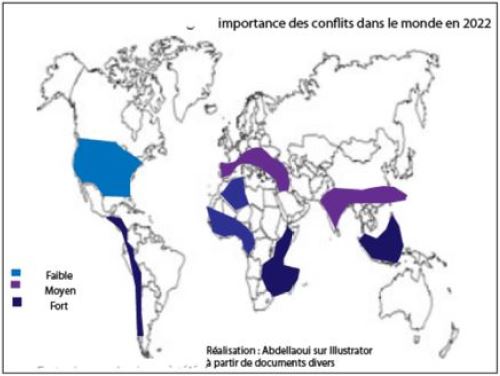
Ferdinand, heir to the Austro-Hungarian throne, and his wife, this event only pushed the tensions stemming previous disputes (strategic, political, economic and colonial rivalries). This war has deep origins which must be analyzed over the long term. The human toll of the First World War amounts to about ten million dead and about eight million invalids, or about 6,000 deaths per day.
Ref: Wikipedia (2022)
Conclusion
In this article, we have recalled the three main types of risk that can irreversibly alter life on Earth. We immediately
ruled out the risk to NEOs, of which we nevertheless recalled a few elements that seemed important
to us for their understanding.
Global warming has been addressed because it can lead to the total disappearance of life on earth if we cannot limit the emission of greenhouse gases. The consequences can be catastrophic and very long-term due to radioactive fallout and atmospheric pollution; we can cite in particular:
• Damage to the food chain due to lack of photosynthesis
• General cooling: nuclear winter
• Destruction of the protective ozone layer from solar radiation
We also discussed the conflicts in the world. We have shown that conflicts which do not directly oppose the superpowers have little chance of generating armed nuclear confrontations. We have, for this purpose, shown a state of the nuclear equipment of the technologically advanced powers, emphasizing the attack submarines.
A more or less exhaustive statement of other, more localized conflicts is recalled.
Bibliography
Wikipédia (2022). les conflits dans le monde actuel 2022; site visité le 4 décembre 2022.

Hi!
We're here to answer your questions!
Send us a message via Whatsapp, and we'll reply the moment we're available!